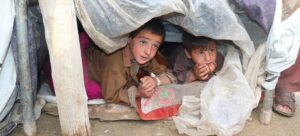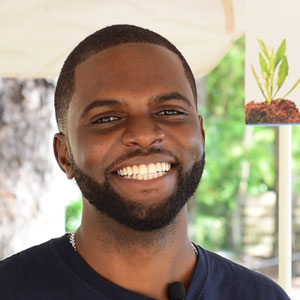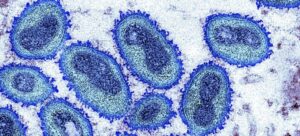Yet this improbable marine wonder is in danger. Scientists, local experts, passionate activists, and islanders are sounding the alarm about the deterioration of one of the richest ecosystems in the Caribbean Sea, even as they work together on innovative ways to restore it.
Get the band saws ready!
It’s 9 am on a Monday in San Martin de Pajares Island, located in a Marine Protected Area where coral reefs can be observed at very little depth and in crystal clear water, and a calm 45-minute boat ride from Cartagena, the most-visited city in the Colombian Caribbean.
Marine Biologist Elvira Alvarado is racing against the clock as resources are limited. She has eight days to plant 13,500 fragments of coral and she’s teaching a group of young volunteers how to do it.
“We are going to start with three tables, get the band saws ready and use dead pieces of coral first to practice!”
She explains to the eager volunteers: “We take one centimetre of coral parts and cut them into five. Then we stick the pieces together over a pyramid shape piece of cement–like a ‘cookie’. They will start growing and then they will fuse. In one year, we will have a whole colony which we can transplant to a reef to restore the ecosystem.”

UN Video/David Mottershead
Marine Biologist Elvira Alvarado teaching how to do micro fragmentation of a coral with an special band saw.
Through her NGO, Ecomares, Ms. Alvarado and her peers have been studying and restoring coral reefs for decades, and now she has joined a nationwide effort: “One million corals for Colombia”.
Launched last year by the Colombian Government as part of the commitments made in the context of the UN Decade of Ecosystem Restoration, the project aims to grow one million fragments of coral and restore 200 hectares of reefs by 2023 – the largest effort of its kind on the American Continent.
The areas targeted for restoration cover the Atlantic and Pacific marine protected regions of the country, and mainly the Seaflower UNESCO Biosphere Reserve, an oceanic archipelago with coral banks, small islands and islets forming part of atolls (ring-shaped reefs), which are rare systems in this part of the world. Indeed, almost 80 per cent of the coral reefs in the Caribbean region have been lost in recent years, battered by coastal development, overfishing, climate change and pollution.
The project also covers Corales del Rosario and San Bernardo National Park – which contains the most extensive, diverse and developed coral reef in the continental Colombian Caribbean coastline – the place that Elvira Alvarado has been visiting since she was a student some 40 years ago.
“I came to study with my professor of invertebrates, and this place was beautiful. It was perfect. It had all the species [living] in the way they should have been. But less than four years after I graduated, I saw the damage and the deterioration of the ecosystem. I saw the near extinction of two species of corals and the black sea urchin,” she reminisces without hiding a slight sadness.
I saw the near extinction of two species of corals and the black sea urchin.
After all, the biologist had witnessed the mass extinction of the Caribbean Acropora staghorn and elkhorn corals in the 1980s, due to a disease outbreak and accelerated by hurricanes, predation, temperature increases due to climate change, and sedimentation caused by pollution, among other impacts.
Acropora corals grow like branches at a relatively quick pace, and historically formed large reef structures and provided habitat for fish and invertebrates. Today, most of these reefs have been reduced to fields of barren rubble – an unnatural state among Caribbean ecosystems.
Ms. Alvarado has made her life’s goal to restore the beauty she once knew, studying the reproduction of these corals as well as other species that live in the Colombian reefs – now also in increasing danger due to worldwide climate change acceleration – and experimenting with ways to repopulate them.
“It’s like in the forest. Yes, we chop the trees, but for every tree we chop, we should plant two. Restoration must be for all the ecosystems. Earth didn’t come to what it is just because of chance, but because of natural selection. Natural selection tells us that these species of corals should be here so that’s what we are doing. For every coral that dies we need to restore and try to produce more individuals genetically different that can survive illnesses or bleaching events in the future,” she explains.

© Ocean Image Bank/Philip Hamilton
A colony of Elkhorn coral, an almost extinct acropora species in the Caribbean.
Setting up a baby coral nursery
On a small boat captained by Yeison Gonzalez, an islander who has lived off the sea since he was born, our UN News team arrived the first day of Elvira’s coral planting ‘marathon’—just ahead of Oceans Day.
“The ocean gives us everything, but it can also take everything from us if we are not good to it. Look! that house got destroyed by a swell,” Mr. Gonzalez tells us as we enter Rosario Islands and just before we dock in Oceanario, a marine life conservation and education centre inside the National Park which is lending space, housing, and equipment to the biologist’s team.

UN News/Laura Quiñones
The entrance of Oceanario, in Corales del Rosario National Park.
Ms. Alvarado’s crew sets up on one of the piers under two tarps. While walking there, we see some of the animals that Oceanario, also a scientific research facility, has been working to protect and educate visitors about, including marine turtles, sharks and all-mighty ‘Mero Guasa’ or Goliath Groper fish that is currently under high threat of extinction [listed by the ICUN as ‘critically endangered’].
Divers, students, and other volunteers, some carrying out large skinny steel bars, gather to listen to Ms. Alvarado’s instructions. The first step is to set up what they call ‘beds’ at the chosen restoration place – Tesoro Island – just a couple of miles away from where we are standing.
“We are building structures in steel that will have mesh on top and will look like a bed. They must be one meter above the substrate [the ocean floor] so that the micro fragments are not suffocated by the sediment”, she says, while a diver draws out a diagram of what they will be shortly doing six metres underwater.

UN Video/David Mottershead
Elvira, divers and volunteers plan how to build a coral nursery underwater in Oceanario Islas del Rosario.
They will set up three tables, and over the next eight days, they will place 900 ‘cookies’ which contain five micro fragments of coral each from eight different species. The number of individuals from each species will depend on the healthy reef pieces divers are able to find and collect.
“For example, the most dominant species right now are the Orbicella, which are the corals that make columnar and pagoda-like structures. They are abundant here, so we have 15 genotypes of each one of them. But of Acropora Palmata, which is a very scarce species in the park after the extinction, we have only two colonies. Of course, we would like to have a lot more, but we don’t have where to get them,” the marine biologist highlights.
Ms. Alvarado stays behind while UN News gets on a boat with the divers who are armed with heavy hammers, steel bars, steel mesh, and a huge roll of measuring tape.
Their work underwater is like a choreographed dance. First, they check for a clear place to set up the bed making sure there are no threats around, such as algae colonies, which compete with corals for resources.
Once they find the perfect place deep enough to be protected but shallow enough to get enough sunlight, the diving crew begins measuring, placing and hammering the metal bars to create a structure.

UN News/Laura Quiñones
Divers putting together a coral nursery in Isla Tesoro, Corales del Rosario National Park, Colombia.
When they are done, their work will resemble an underwater dinner table with dozens of coral micro pieces on top, which will ultimately branch out into coral colonies.
Slow-growing species placed in these beds will take about 1 to 1.5 years to grow enough to be transplanted into the larger reefs, completing the restoration. Once in the reefs, about 70 to 80% will survive and become part of a larger colony.
The magic of corals and their reproductive process
Very few people outside of marine biologists, divers, and sea aficionados like this reporter, seem to know that corals aren’t rocks or plants, but animals whose function is extremely vital for the survival of our oceans and even to our survival as humans.
Tourists and travellers often enjoy casual snorkelling trips around the world, and while it’s understandable that colourful fish, turtles, and other marine life may be more ‘popular’, it’s a mistake for them to overlook the staggering and complex beauty of corals, the living, breathing ‘structures’ that harbour and feed most of the denizens of the deep.
Corals are small marine colonial animals. They consist of many individual creatures called polyps who live and grow while connected to each other and are dependent on one another for survival.
They feed off plankton – if one polyp eats, the whole colony does – and live in perfect symbiosis [a mutually beneficial relationship] with a microalgae which gives them their bright colours.
The coral provides the algae, officially called zooxanthellae, with a protected environment and the compounds they need for photosynthesis and in return, the algae produce oxygen and give the coral a supply of glucose or energy, or, as we know it: the stuff of life.
During times of environmental stress –such as increased water temperature or salinity– the coral release the colorful algae from their tissues, which is what causes them to appear white [known as bleaching], and to be at risk of dying.
There are over six thousand coral species in the world, and at least 80 call Colombia their home. Each of them is unique and beautiful in its own way with amazing and diverse shapes and colours.

UN News/Laura Quiñones
Fish swim over coral nurseries in Corales del Rosario National Park, Colombia.
In Corales del Rosario National Park we were able to spot some of these creatures up close. Some looked like big yellow brains floating in the ocean blue, others extended like underwater bunches of daisies, while others formed orange ‘pyramids’, and still others were so soft they swayed with the underwater currents in a hypnotic and inspiring dance.
Getting up close with coral is an amazing spectacle for nature lovers, but marine biologists can’t get enough of them because of the unique ways in which they function and reproduce.
Jaime Rojas, Scientific Director of the Research, Education and Recreation Centre (CEINER) in Oceanario, along with Ms. Alvarado, has been investigating for decades the different types of sexual and asexual reproduction of corals.
“Most corals [sexually] reproduce only once a year, and with certain species you must know exactly what day and what time this happens in order to collect the male and female reproductive products,” he emphasises.
Thanks to the permanent and diverse coral nurseries the Centre maintains, experts were able to identify the nearly extinct Elkhorn and Staghorn corals exact reproduction day and time, a first for Colombia.
“With that information, we collect the sexual products [eggs and sperm] and then go to the laboratory and do the fertilization and develop research in the cultivation of coral larvae. This is a strong line of work that we have in Oceanario with many allies and experts – even at the international level – and the hope is in the future to repopulate our reefs with these lab larvae”, he explains.
It typically takes coral 25 to 75 years to reach sexual maturity, one of the reasons why scientists have been betting on asexual reproduction as a quicker way to restore reefs, but the work on sexual reproduction is vital to keep a genetic bank of different coral species for the future.
Different types of nurseries
The most popular technique to grow and restore corals is the one Elvira and her team – as well as the over 32 allies all over Colombia are implementing – micro fragmentation.
The process of cutting small pieces of coral to encourage growth has been around since the 1960’s, but it was only in 2018 that a biologist in Florida accidentally discovered that cutting them into even smaller pieces made them grow faster.
Dr. David Vaughan mistakenly broke a staghorn coral that he had been growing for three years and the fragments fell to the bottom of a tank. To his surprise and shock, just weeks later, he observed that the small fragments had grown to the original size of the broken piece.
Ultimately, this technique makes corals grow 40 times faster than they would in the wild, providing hope for reefs worldwide.
Inside Oceanario, which is also one of the largest contributors to the One Million Corals for Colombia project, visitors – including children and local fishermen – are learning about this process in special sessions, and through a permanent underwater display of different kind of nurseries.
“We implement three different cultivation techniques. We have coral trees and rope-type nurseries that are for species with fast branching growth, and we have table-type nurseries for micro fragmentation of slow growing species,” Oceanario’s Marine Biologist Alexandra Hernández highlights.

UN News/Laura Quiñones
Tree-type coral nursery in Oceanario, Corales del Rosario National Park, Colombia.
To submerge oneself into the water with these nurseries feels like witnessing a miracle in the making.
It somehow resembles a backyard garden underwater. You see clothing lines, but instead of socks and t-shirts, there are little pieces of coral dangling there. Then there are the floating trees, with staghorn corals branching out like bananas.
And then you can see the tables, which have interesting shapes to make them even more beautiful – resembling a plane or a shipwreck – filled with all kinds of corals and colourful fish swimming around.
“With our work we don’t only seek to restore and leave it at that – because any restoration project that does not involve the community is destined to be lost. We can restore corals, but if we don’t teach people why they should be cared for, why they should be protected, what this work is like, people won’t value it and therefore it won’t take care of it,” Ms. Hernandez adds.

UN News/Laura Quiñones
Fragments of Acropora corals growing on a rope-type nursery in Oceanario, Colombia.
‘Life brings more life’
Coral reefs have survived the extinction of the dinosaurs, the ice age, and other massive environmental shifts, and with some help, they will survive the climatic changes that have thus far characterized the early 21st century.
Much is at stake: in addition to their natural beauty and the animal and plant species that depend on them to survive, coral reefs provide us, humans, with food security through fishing; protect us from flooding and storms; and generate income thanks to the millions of tourists and divers who travel to appreciate them. Some have anti-inflammatory properties, while others provide the raw material for some cancer-fighting medicines.
“Life brings more life, so when you restore these places that were initially degraded, you bring living fragments and they begin to grow, life will arrive, and with-it fish. And with the fish also comes the resurgence of the economic activities of the people of the region. This is beneficial for everyone and for the environment; let’s remember that 70 per cent of the oxygen we breathe is thanks to the oceans,” Ms. Hernández highlights.

Ecomares/Andrés Obregón
Elvira Alvarado dives along her peers in Colombia.
A restoration project in Indonesia is living proof of her words. Scientists and community in Salisi’ Besar, South Sulawesi, planted 12,600 coral fragments in 2019. By 2021, reef coverage had increased from 1 per cent to more than 70 per cent, and marine life had increased by some 300 per cent. Fittingly, the restoration site was named ‘Hope Reef’.
“We need the biogeochemical cycles that come from this ecosystem. We need the fish, we need the lobster, we need the [sea] barrier. What is going to happen in 30 years when climate change raises the sea level if we don’t have that barrier? We’re going to have a lot of things happening,” adds Elvira Alvarado.
For both biologists, the importance of coral reefs and their restoration must go beyond the scientific community and divers and capture the general public’s attention.
“We need all these kinds of ecosystems. It’s not a question of what marine biologists love doing, it’s a question of why we do it: we do it because the people in the world need us. What would have happened if Jacques Cousteau hadn’t talked to us? No one would have known what we have in our oceans. We have to speak. We have to learn,” Elvira Alvarado highlights.

UN News/Laura Quiñones
Elvira Alvarado, Ecomares Marine Biologist, has been working for decades in coral research and restoration.
A ‘blue’ country
Those who are involved in the Million Corals for Colombia project deeply understand this message: in ecosystem restoration, as in many other efforts to reach a sustainable world, unity is power. Allies in the combat to save the planet can range from scientific experts like Ms. Alvarado, Ms. Hernandez, and Mr. Rojas, to diving schools, local communities, fishermen who work as coral gardeners, and even hotels.
Milena Marrugo works for Conservation International, the implementing partner organization which oversees the Million Corals project and coordinates the work of the actors working in the field. She accompanied UN News on the boat ride back to Cartagena.
“For many years this [restoration] work was very difficult, because everyone was working independently. In the past, allies had made the greatest effort working with whatever little they had, with few resources, and now being all truly united for a single purpose makes all the effort even greater and makes it possible for us to achieve such a high goal,” she says, adding that it is really important that the Government, which is making a big financial investment in the project, has begun to take notice of the importance of ocean restoration.
Ms. Marrugo explains that the project has also brought to light the amazing- and sometimes challenging- differences of the locations in which the coral restoration is being implemented all over Colombia. Not only because of the people, which include indigenous, Afro-Colombian and other coastal communities working hand in hand, but because of the diverse marine conditions.
“There are some areas where there is a lot of current, so certain types of nurseries are not possible. We have had to vary and experiment with different characteristics: now we have rope, table, star, spider, we have vertical and horizontal and other nursery variations. For example, in the Pacific, we realized that rope nurseries were going to be a problem for the migrating humpback whales”.

Colombian Environment Ministry
Divers pose with transplanted corals and a ‘One Million Corals for Colombia’ sign, the name of the biggest ocean restoration project in Latin-America.
The expert also highlights that these nurseries are being mostly built with eco-friendly or recycled materials that can be reused to continue the work in the future, because, from her perspective, the project cannot end after reaching the one million coral fragments.
“We want to take our corals, which are already in a nursery phase, to their natural environment so that they fulfil the fundamental role of truly restoring the reef, achieving these 200 hectares restored. This is one more step that we are working to achieve,” she adds, highlighting that nurseries also need constant maintenance and cleaning which takes time and money.
Don’t forget, although Colombia has always been seen as a ‘green country’ with its mountains and rich terrestrial ecosystems and biodiversity, almost half of its territory – some 48 per cent – is stretched between the Caribbean Sea and the Pacific Ocean.
“All life comes from the sea, but we have turned our backs on it. I live in the city of Cartagena where most people don’t even look over their shoulders to appreciate the beautiful sea and ecosystems they have. We must teach our children right now so that future generations really understand the importance of what the ocean provides for all of society.”
This is Ms. Marrugo’s message and a call to action for us all.
*According to Conservation International, as of the date of this article, there are more than 230,000 coral fragments in nurseries in Colombia, and over 12,000 have been transplanted to reefs.
This is Part I in a series of features on ocean restoration efforts in Colombia. Coming up next, we travel to the island of Providencia in the Seaflower UNESCO Biosphere Reserve, which was devastated by hurricane Iota in 2020. Evidence of the destruction wrought by the storm is still visible and the damage has severely impacted not only human infrastructure but also crucial carbon-capture ecosystems such as mangroves.































